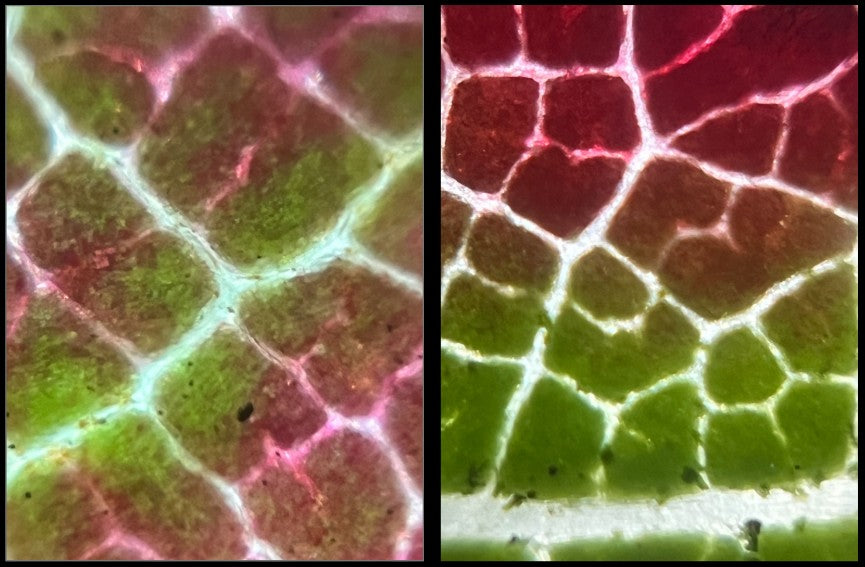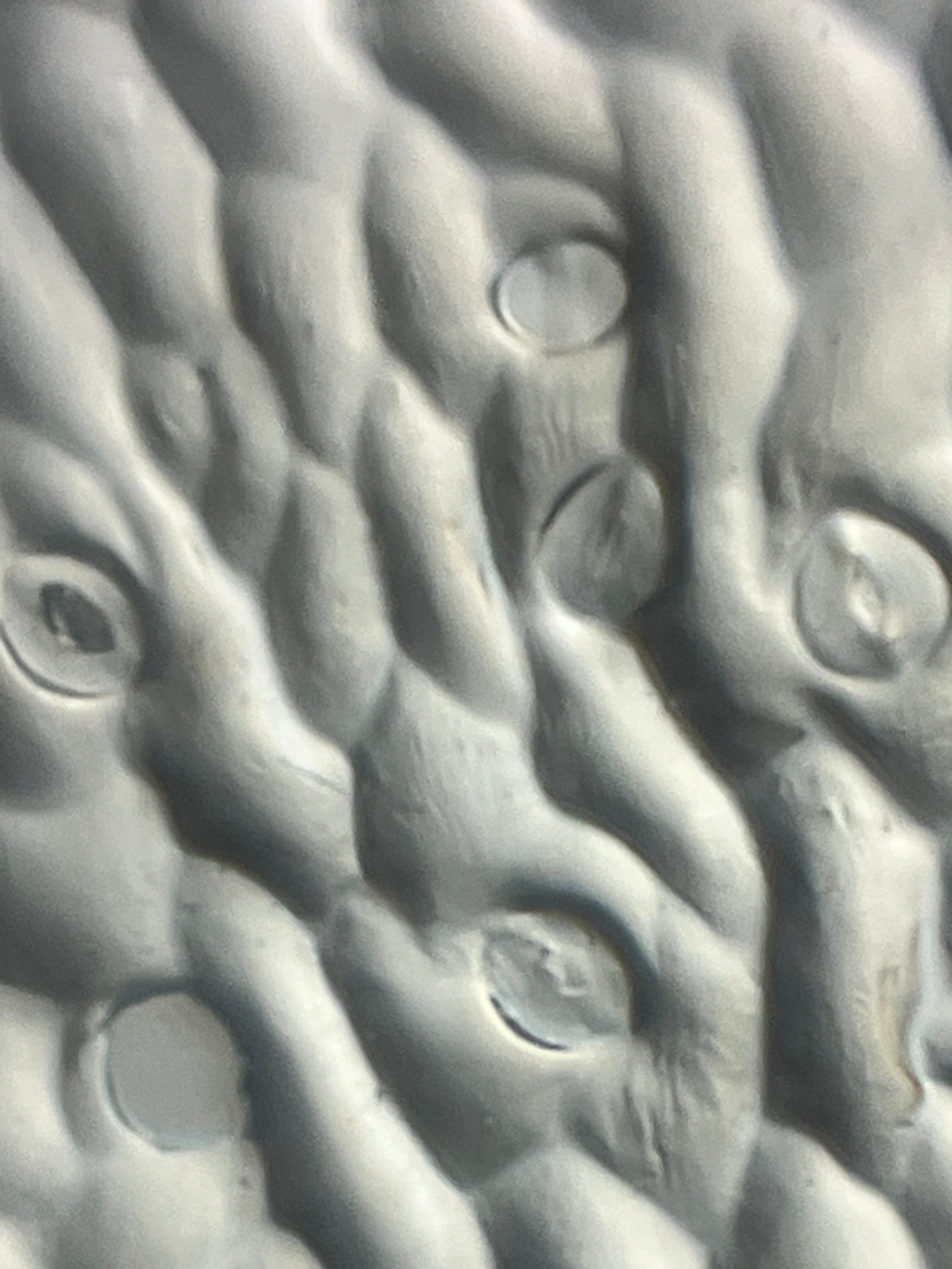Question Prompt:
What hidden microscopic structures can you discover on fruits?

Figure 1. Montage of fruits from my garden
(Photo Credit: Holly A. Stuart)
Whether you choose to address the question prompt above or create your own questions, you and your students can take a deep dive into the microscopic world of fruit with a classroom set of Foldscopes.
The summer is heating up and many of the flowers we studied last month are producing fruits. From green beans to blueberries, delicious and ripe fruits are hopefully part of your classroom snack time! Even though we want our students to eat all of these healthy foods, I recommend setting aside a few fruits for microscopic study, too.

Figure 2. The bumpy surface of a pepper skin (left) and tomato skin (right) viewed under a Foldscope 2.0 at 140X magnification plus 5X digital zoom on phone
(Photo Credit: Holly A. Stuart)
Background:
The flowers that formed in the spring are transforming into the fruits of summer. Once the ovules are fertilized by pollen, they become seeds. This causes the ovary, the structure that holds the ovules, to grow and form the fruit which protects the seeds until they are ready to grow into new plants. Fruits and their skins have a variety of coverings that can be smooth, hairy, thin, or thick. While many of these features can be seen with the naked eye, a microscope reveals some of the hidden structures on the fruit’s surface.

Figure 3. The cells and pigmentation of a blueberry skin viewed under a Foldscope 2.0 at 140X magnification plus 5X digital zoom on phone
(Photo Credit: Holly A. Stuart)
This month you will study the microscopic adaptations of fruit skins that help plants to survive. This blog includes sample ideas, slide techniques, and student research ideas to guide you and your class’s longitudinal study in the garden!
Materials:
-
Dissecting Kit or Set of Tweezers
-
Blank Trading Cards or Glass Slides
-
Clear Stickers or Coverslips
-
A Variety of Fruits (with thin, easy to peel skins)
 Figure 4. Green bean cross section viewed under a Foldscope 2.0 at 50X magnification
Figure 4. Green bean cross section viewed under a Foldscope 2.0 at 50X magnification
(Photo Credit: Holly A. Stuart)
Sample Preparation and Slide Techniques
The best fruits for quick and easy slide mounting are fruits that have a thin, easy to peel skin. The raspberry was so thin that I was able to just place a small segment of the fruit on a slide and press down with a cover slip (tape the edges of the coverslip to hold it in place inside of the Foldscope). The blueberry, tomato, and pepper skins were removed using a pair of tweezers. The skins were mounted on slides and secured with either clear stickers or coverslips.
The green bean’s thicker skin required the use of a scalpel from a dissecting kit to cut either a cross section or a longitudinal slice. The sample was then mounted on slides in the same manner described above. Experiment with the fruits you have in your garden. The key is to make them thin enough that light can pass through them. NOTE: If the skin is very thick and opaque, you can always use the reflective lighting technique with the 2.0 LED light module to observe the skin surface.
Color
The fruit peel, also called the epicarp, is there to protect the seed from fluctuating environmental factors such as humidity and temperature. It is also there to attract animals who will eat the fruit and disperse the seeds far and wide after the fruit has been digested. For this purpose, fruit peels come in many different colors. Scientists think that redder fruits are more attractive to birds while greener fruits tend to attract mammals. It is believed that this is due to the way that different animals perceive color.
But do fruit skins of the same color all look the same on the microscopic scale? This question was addressed in the blog Foldscope Explores… The Color Red. Your students can investigate further by placing fruits that have the same color on the macroscopic scale under the Foldscope, to compare/contrast the microscopic colors. Some examples might include:
-
Red: peppers, strawberries, raspberries
-
Orange: peppers, tomatoes, and persimmon
-
Yellow: peppers, tomatoes, golden delicious apple
-
Green: peppers, granny smith apple, grapes
-
Blue: blueberries, juniper berries, huckleberries
-
Purple: blackberries, plums, grapes

Figure 5. Picture of three red fruit skins (pepper, raspberry, and strawberry) viewed under a Foldscope 2.0 at 140X magnification plus 5X digital zoom on phone
(Photo Credit: Holly A. Stuart)
Trichomes
You might discover that the surface of your fruit looks hairy. These hairs, otherwise known as trichomes, are protective structures that prevent fruits from being eaten by pests, provide a barrier that maintains moisture levels, and contain glands that produce essential oils or defensive chemicals. Sometimes you can find trichomes on other parts of the plant too, not just the fruit. Your students might decide to study the structural differences of trichomes from a single plant (i.e. flower vs. leaf vs. stem) or do a comparison of different types of fruits.

Figure 6. Fruit trichomes (raspberry left, green bean right) viewed under a Foldscope 2.0 at 140X magnification plus 5X digital zoom on phone
(Photo Credit: Holly A. Stuart)
In addition to the slide preparation ideas mentioned above, you can try taking a clear sticker and applying it to the surface of the fruit to pick up the trichomes. This would allow you to observe the trichome without the skin of the fruit.

Figure 7. Collecting green bean trichomes using tape (left), green bean trichome viewed under Foldscope 2.0 at 140X magnification plus 5X digital zoom on phone (middle), and 340X magnification plus 5X digital zoom on phone (right)
(Photo Credit: Holly A. Stuart)
Connect:
Remember, these are only suggestions to guide you along your garden study. What questions do your students want to answer? What fruits are ripening in your garden now? Let us know! Share your observations, discoveries, and pictures with the Foldscope community on the Microcosmos. Your contributions will build up a strong scientific database that can help support new and innovative scientific research. Tag us on social media, too. We love to see how Foldscopers around the world are using their Foldscopes in new and innovative ways!
Next month we’ll return to the soil to see what has been happening underground to support all that we are seeing aboveground. Until then, happy gardening and Foldscoping!

Figure 8. Soil
(Photo Credit: Holly A. Stuart)
Facebook: @Foldscope
Instagram: @teamfoldscope
Blue Sky: @teamfoldscope.bsky.social
TikTok: @foldscope
Threads: @teamfoldscope
Twitter: @TeamFoldscope
Sources:
https://www.earth.com/news/color-fruit-evolved-attract-animals/
https://specialtycropgrower.com/trichomes-plant-organs-florida/



